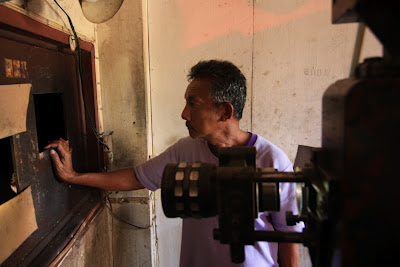The life of the projectionist is one of silent toil. His work is carried out in stuffy quarters, beside noisy machines, usually alone, yet it's the basis of mass entertainment. He is like a conductor in that sense, a disc jockey, only without the notoriety that comes with being seen or heard. As an occupation, the projectionist is the faceless link in the movie industry supply chain. A critical link, no doubt, but one which is fast losing its prestige, if not its place in the industry.

Amnuay is a veteran projectionist. A true old hand. He got his start as the projectionist at the Sri Surin Theater in neighboring Surin province before moving to the Sisaket Rama in the provincial capital. Both theaters are now out of business. A decade has gone by since he got his third gig as projectionist at the Thai Rama here in Uthumphon Pisai. Notwithstanding a miracle, there won't be another chance to practice his craft should this gig expire. Fortunately, the Thai Rama sustains, if for no other reason than its owner enjoys running it. A bastion of family entertainment in small town Isan. The owner's rock bottom entrance fee of 20 baht is the lowest in the country, making the big screen accessible for even the most pecuniary. In the second decade of the 21st century, an active stand-alone theater in rural Thailand is a rare occurrence.
Amnuay opens the lamphouse of his projector, revealing the xenon bulb.
Amnuay mans a clunky, two-reel changeover projection system that could be in a museum. It's at least as old as the theater itself, which dates to 1977. In the working life of projection equipment, that's grandfatherly. Only with a lot of extra tweaking and coddling are these machines able to perform.
A cacophony of motors sets an industrial mood in the projection room. Antiquated projectors require hawkish attention. At times they caused the on-screen picture to shake, the result of a loose imaging lens. The audio system failed for a moment, too, leaving the audience of 20 or so in unintended silence. The amount of attention required just to ensure a steady picture, an even light source, is praiseworthy. This is no mindless task. Tedious, yes, but skilled no less.
When one reel has nearly finished, Amnuay switches on the other projector. The so-called "changeover" system staying true to its name. The expired reel is then removed and taken to an adjacent room where it's rewound by hand.
Split view
Rewinding by hand
The rewinding bit seems to have a meditative quality. In the minute or two it takes Amnuay to complete a reel he seems lost in thought, watching as the film shrinks from one reel only to grow, correspondingly, into a tightly wound circle on the other. Occasionally he glances out the wall opening towards the distant screen, checking that the film is playing smoothly in his absence.
Above the wall opening hang portraits of the King and Queen. Most businesses in Thailand keep images of royalty prominently displayed. In this day and age, to not is to rouse suspicions. The portraits on display in the Thai Rama are inscribed with blessings of good luck and prosperity. They've presided over this room since the beginning.
Amnuay pauses, staring blankly into existential nothingness as the movie plays on in the background.
While the projectors hum away, clamorous in their melody, Amnuay takes a moment to read the newspaper. Moments like these mark the completion of a reel cycle. Several minutes pass this way before he returns to the machine to adjust its components. It takes about 5 or 6 reels to complete a typical feature film.
A smoke break provides Amnuay a moment to take in the movie.
Another solitary moment for Amnuay, his machines clanking away in the background. It was not too long ago, he recalled, when the theater was full on a regular basis. The Thai Rama had an original seating capacity of one-thousand. Now only 200 seats remain, the rest sold off as scrap.
The projectors in this steamy little room are aged artifacts. When they go, so will the theater. Projectionists like Amnuay, operators of these aged artifacts, are like members of a fading guild. They are a breed of their own. To see the occupation at this particular point is to watch occupational Darwinism unfold before your very eyes. A sterile silence awaits this room where dreams have been projected twice a day since 1977.
Amnuay shrugs and cracks a smile before loading another reel.




































































